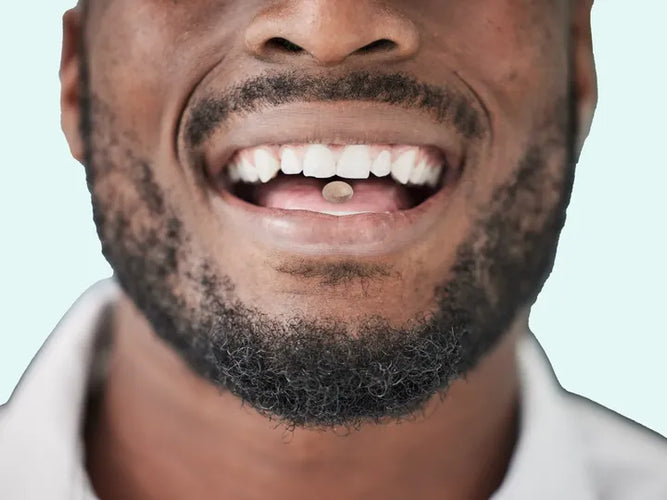Vitamin D has a role in the body in supporting the normal function of hair follicles. Hair follicles are the parts of the scalp where hair grows. Vitamin D is also involved in processes such as cell division and tissue renewal, which are important for healthy hair. If vitamin D levels are low for a longer period of time, hair follicles may enter the resting phase of the hair growth cycle more often. This can be associated with increased hair shedding.
In autumn and winter, the body produces less vitamin D due to reduced sunlight. This is why many people wonder how vitamin D is linked to hair loss. In this blog, you will learn what vitamin D does for your hair, which signs may point to a deficiency or an excess, and what you can do to support healthy hair.
Can a vitamin D deficiency cause hair loss?
Yes, a lack of vitamin D can make hair loss worse. This vitamin helps hair follicles, the places where hair grows, to stay active. When there is enough vitamin D in the body, hair follicles are able to produce new hair. When vitamin D levels are low, hair follicles can move into a kind of resting state. This is called the resting phase of the hair growth cycle. During this phase, hair grows more slowly or hair shedding may occur. The resting phase is a normal part of the cycle, but when there is a deficiency, this phase can last longer.
Some people are at higher risk of vitamin D deficiency
- People with darker skin. Their bodies produce vitamin D more slowly from sunlight.
- People who spend little time outdoors or often wear covering clothing.
- Older adults: as the skin ages, it produces less vitamin D.
Are you in one of these groups and have you noticed changes in your hair? Discuss it with your general practitioner. He or she can arrange a blood test to check if you have a vitamin D deficiency. This could be one of the possible causes of excessive hair loss.
Can you get too much vitamin D?
Yes, you can also have too much vitamin D. Especially if you take supplements for a long period without knowing whether you actually have a deficiency. Vitamin D is stored in the body, and excess amounts can be harmful. Symptoms may include nausea, headaches, or kidney problems.
So remember: more is not always better. Taking extra vitamin D only makes sense if your body is truly lacking it. Always get tested first before starting supplements. This way you know exactly what your body needs.
What can you do about hair loss caused by vitamin D deficiency?
If you have been diagnosed with a vitamin D deficiency and you think this is making your hair thinner or causing hair loss, there are ways to address it:
Get your levels tested
Especially if hair loss continues or you belong to a risk group. Supplementing without testing can lead to excessive intake.
Get daylight exposure
Your body makes vitamin D in the skin, but it needs sunlight for this process. Try to be outside for 15 to 30 minutes a day with uncovered skin such as your face or hands. How much sun you need also depends on your skin tone: the more pigment your skin contains, the longer it takes for your body to produce enough vitamin D.
Eat foods that contain vitamin D
Food can help you increase your vitamin D intake. It is found in oily fish such as salmon and herring, eggs, and margarine. However, to be honest: diet alone is usually not enough.
Consider a supplement (after testing/advice)
Sometimes it is necessary to top up your vitamin D with a supplement. Choose a dosage that fits your test results and personal situation. Follow the label and professional advice. You might also want to check whether you are getting other important nutrients such as zinc, vitamin B12, and iron. These can all help keep your hair healthy and strong.
A broad-spectrum supplement like the Neofollics Hair Growth Supporting Tablets can also be a useful addition. These tablets support hair from within and help stimulate natural hair growth. Because they work on multiple factors at once, they can be valuable for many types of hair loss. They can safely be combined with vitamin D supplements.
Note: Hair loss usually has more than one cause. Vitamin D is just one piece of the puzzle.
Frequently Asked Questions
Can I just start taking vitamin D supplements?
It is always best to first check officially if you have a deficiency. You can do this with a blood test at your general practitioner.
What happens if you get too much vitamin D?
You may develop side effects such as vomiting, constipation, reduced appetite, and weight loss.
Does extra vitamin D help if I don’t have a deficiency?
No: in fact, it can quickly lead to excess, which may be harmful.
Conclusion
Vitamin D plays a supportive role in your body and can also affect your hair. Low levels are more common in autumn and winter, and in groups that naturally produce or take in less vitamin D (for example people with darker skin, those who stay indoors a lot, or older adults). When levels are low, hair follicles may spend more time in the resting phase. This can make hair look thinner and cause more shedding or diffuse hair loss.
It is rarely the only cause. Hair loss usually results from a combination of factors. The best approach is:
- Testing: a blood test shows if you belong to a risk group or have low levels.
- Lifestyle: get daily daylight and eat a varied diet with vitamin D sources (oily fish, eggs, fortified foods).
- Supplementation: only consider supplements if your levels are low or if recommended. More is not always better, too much can be harmful.
- Look wider: other nutrients like zinc, iron, vitamin B12 and protein matter too. Also pay attention to stress, sleep, and scalp care. Discuss treatment options with your gereral practitioner or dermatologist if needed.
In short: see vitamin D as one piece of the hair growth puzzle. Measure when needed, supplement wisely, and stay consistent. If hair loss continues or worsens, always seek medical advice.
Sources
Chen, Y., et al. (2024). Serum 25-hydroxyvitamin D in non-scarring alopecia: A systematic review and meta-analysis. Journal of Cosmetic Dermatology.
Cianferotti, L., Cox, M., Skorija, K., & Demay, M. B. (2007). Vitamin D receptor is essential for normal keratinocyte stem cell function. PNAS, 104(22).
Demay, M. B. (2007). Role of the vitamin D receptor in hair follicle biology. Journal of Steroid Biochemistry and Molecular Biology.
Hassan, G. F. R., et al. (2022). Oral vitamin D, topical minoxidil, or both in female pattern hair loss. Journal of Cosmetic Dermatology.
This information does not replace professional medical advice. If in doubt, always consult a doctor or specialist.














